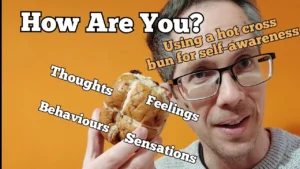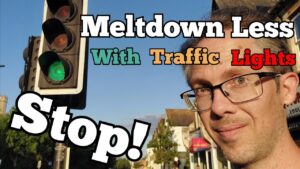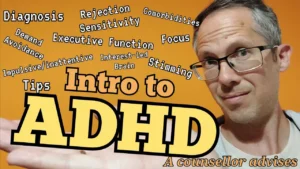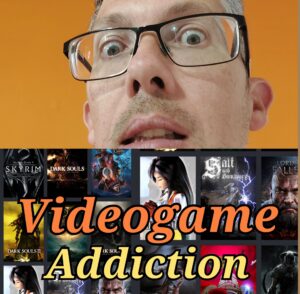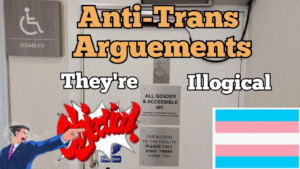Contents
AD/HD Intro
An overview of Attention Deficit/ Hyperactivity Disorder
Tips for getting the most from this article/video
You can read this article which summarises the points or watch it as a video. If you do the later, I have three tips to help you, as an ADHDer, to get the most from this video:
- Adjust the playback speed to 1.5 – 2 x the regular speed
As an ADHDer, you will have a beautiful brain that thinks loads quicker than I speak. Adjusting the speed will give my voice chance to compete with the speed of your thoughts. It also makes it more challenging to listen to, and things that are challenging can be more engaging and easier to focus on than videos that are less challenging to listen to.
- Read Along
The more senses you can engage the better. Listening to this video whilst reading the article gives it two chances to go into your brain. As a dyslexic, when I go to lectures, I often write notes (not to re-read them) as the act of writing helps me to listen. If you watched the video passively, e.g. as background music whilst you cooked a meal, skimming this article will help the info sink in.
- Skip Ahead
Use the content page to read the parts that are of use to you. You don’t have to read this entire article. It’s okay to skip sections or come back to it.
Beyond The Label
This section we will look at ther label: AD/DH (Attention Deficit/Hyperactivity Disorder) and examine it
1. The ‘/’ I’ve put between AD/HD
Back in 1968, there was no AD. It was just HD (“Hyperkinetic Reaction of Childhood to be precise). Then the DSM, the diagnosis and statistical manual, updated in 1980, and at that point, attention deficit disorder (ADD) was added. And then finally in 1987 we got the words that we have today, Attention Deficit Hyperactivity Disorder and ADD became an old diagnostic term that’s not used anymore.
2. One neurotype or two?
– The attention deficit refers to the Inattentive Type of ADHD and that makes up around about 30% of ADHDers.
– The Hyperactive or Impulsive Type makes up around about 10% of ADHDers, and that’s the hyperactive disorder part of ADHD.
– The other 60% of ADHDers are Combined Type. They’re both inattentive and impulsive. They are attention deficit and hyperactive. So the majority of ADHDers are both Inattentive and Impulsive (AD and HD), there is a lot of cross over between the two subtypes, and the same Executive Functions and other traits will affect both Impulsive and Inattentive. It is then both one neurotype, and two.
3. Is ADHD a Disorder?
Yes
– Under the Equality Act, 2010, ADHD is recognized as a disability.
– To get diagnosed with ADHD, The diagnostic criteria need to be causing actual impairment in your life rather than just ticking the criteria I’ll cover in the next section.
– It’s a neurodevelopmental condition which impacts on brain development of Executive Function Skills. Executive Functional areas of the brain will develop 30% slower and by aged 30 will be at 75% of the capacity of a neurotypical.
No
– it’s not a disorder, It’s a neurotype. You’re neurodivergent, not defective. You’re trying to operate and live in a world which is designed for neurotypical people which you are at a disadvantage of which we’ll cover in the Social Model of Disability.
– There are many positives such as creativity & divergent thinking that come with being an ADHDer.
– Identity First Language.
Rather than saying somebody has ADHD, I’m saying somebody is an ADHDer. ADHD is such a big part of somebody’s identity that if you were to remove it from them, you would be changing their whole brain makeup and identity. In that respect, it feels unethical to call someone’s neurotype, their way of being, disordered. It’s not defective.
ADHD Diagnosis
I am not a psychiatrist or registered professional who can diagnose you with ADHD. I will however cover the criteria to give you a flavour of what ADHD is and indications of whether or not you have Inattentive, Impulsive, or Combined Type AD/DH.
If you are looking for a formal diagnosis in England, go to your GP and get on the waiting list for:
– The NHS
– The Right to Choose,
– Pay for a Private Diagnostic
Diagnosis Stats
- 2 – 5% of adults are ADHDers
- 30% of those Inattentive, 10% Impulsive, the rest Combined.
Requirements for Diagnosis
- These nine criteria (9 for Impulsive, 9 for Inattentive) must be present for more than 6 months.
- They must be developmental rather than something that you have acquired, i.e. they must have been with you since before you were 12.
- They need to not be explained by another medical condition like trauma.
- They need to be causing you very real-world impairment.
- They need to be present in at least two or more settings (e.g. both at home and at work so the setting isn’t what is explaining the symptoms).
- They need to be diagnosed by a trained licensed health professional.
- if you are under 17, you need to tick 6/9 to meet the diagnostic thresholds. If you are over 17, you will be better at masking and so need to tick 5.
- For the Inattentive traits, as an adult, you likely have apps and coping strategies so consider answering how you would cope without those strategies e.g. how would your scheduling be without notifications on your phone.
- For the Impulsive Traits, you will likely mask or direct some of the traits internally (especially if you are female) so instead of ticking that you climb when you shouldn’t, it may be that you feel restless or have a compulsion to move.
The 9 Diagnostic Traits
It can be helpful to tick which ones apply or to collect something like a sweet for each one to see if you have 5/6 by the end for each type. This won’t formally diagnose you, but will give you a sense of if you are an ADHDer and which subtype(s).
Inattentive
1.Often fails to give close attention to details or makes careless mistakes in schoolwork, at work, or with other activities. |
2.Often has trouble holding attention on tasks or play activities |
3.Often does not seem to listen when spoken to directly |
4.Often does not follow through on instructions and fails to finish schoolwork, chores, or duties in the workplace (e.g. loses focus or gets side tracked) |
5.Often has trouble organising tasks and activities |
6.Often avoids, dislikes, or is reluctant to do tasks that require mental effort over a long period of time (such as school work or homework) |
7.Often loses things necessary for tasks and activities (e.g. school materials, pencils, books, tools, wallets….) |
8.Is often easily distracted |
9.Is often forgetful in daily activities |
Impulsive (Hyperactive)
1.Often fidgets with or taps hands or feet, or squirms in seat |
2.Often leaves seat in situations when remaining seated is expected |
3.Often runs about or climbs in situations where it is not appropriate (in adults, limited to a feeling of restlessness) |
4.Often unable to play or take part in leisure activities quietly |
5.Often ‘on the go’, acting as if ‘driven by a motor’ |
6.Often talks excessively |
7.Often blurts out an answer before a question has been completed |
8.Often has trouble waiting their turn |
9.Often interrupts or intrudes on others (e.g. butts into conversations or games |
Executive Functions
ADHD is a Neurodevelopmental Condition affecting brain development in areas related to Executive Function as well as affecting the susceptibility to different neurotransmitters such as dopamine and noradrenaline.
There are 8 Executive Function Skills. Not all of them will be affected in each ADHDer, and understanding them can help you to seek help for specific difficulties. There are several aps, for example, that can help with some of these areas.
1. Working Memory
Is the ability to hold information within the short-term memory and be able to manipulate that information. An example might be me saying a 5-digit number to you and asking you to repeat it backwards to me.
2. Self-Monitoring
The ability to be aware of our thoughts, our behaviours, our feelings; being able to evaluate them, to give ourselves feedback and edit them.
3. Self-Control
Concerns our inhibitions. Being able to hold back, to delay gratification, and to not act on our impulses.
4. Emotional Regulation
ADHDers can be beautifully vibrant, sensitive people who are very much in touch with their feelings. But their feelings can also be quite large and impactful. Emotional regulation is about being able recognise, contain, and not feel quite as overwhelmed by our emotions.
5. Flexibility
Being able to shift between tasks, particularly if we’re experiencing hyperfocus. To adapt when routines change and being able to thrive without schedules.
6. Planning, Prioritizing, and Time management
It’s about time perception, about being able to estimate what our focus will be like and how long tasks will take. Being able to prioritize deadlines based on how urgent they are or how important they are.
7. Task Initiation
Particularly on tasks which don’t match with an Interest-Led Brain. It’s about overcoming procrastination and being able to start on certain tasks or activities.
8. Organization
The ability to organize attention, impulsivity, and tasks to be structured and organized. It’s the thing that impacts on how messy our room might be, for example.
Just as the 9 traits of diagnosis will be varied in what is ticked for each ADHDer, the 8 Executive Functions will impact on different ADHDers in different ways. No two ADHDers will be exactly the same, though some of the challenges will be shared. One language to describe this is Spikey Profiles which highlight the uniqueness of the individual with some strengths and other weaknesses rather than a simple spectrum of More or less ADHD.
The Interest Led Brain
There are four different motivators that really drive an ADHD brain. It’s about working WITH those motivators rather than trying to work AGAINST them.
I want you to imagine that you are trying to force yourself: “Focus! Stop procrastinating! Sit still!”
Imagine just how much resistance, how much frustration, how much self-lame, and how much fatigue might come about because of that.
Instead, if we can work out the drives of an ADHD brain and flow with them, or even be able to add these elements to tasks which we might be putting off or struggling with, like adding spice to a bland meal, then these tasks that were difficult become easier.
The Four Motivators
1. Interest
Doing those things that you can hyperfocus on, that are interesting, exciting, your passions, your special interests; doing the things that make you tick, that you enjoy.
2. Novelty
Doing things that a new or existing things in a different way so as to add novelty in this unique experience. As we do repetitive tasks, they lose excitement compared to novel tasks or activities.
3. Challenge
Not so much of a challenge that it’s crippling, but in some way that there is a challenge to it – slightly more difficult to add a bit of a hit to the task.
4. Urgent
The deadlines that are running out and about to expire. Not having time, and being rushed adds an excitement to urgent tasks.
An example in producing this video on ADHD:
I was interested in it already, and have been for a while, but after a day of filming it can get tedious and hard to work on. I could say, “How much can I do in one hour?” to work on Challenge to almost gamify it. For Urgency, I could say, “No one’s monitoring or expecting me to get this video out at a certain pace, but I’m going to set a deadline and say it needs to be done by Saturday.” On Novel experiences, I decided to change my t-shirt after every shot to add a newness to the filming and also involve my body compared to just holding up a phone and filming by my messy desk.
So if there’s a task you’re struggling with, maybe you’re procrastinating or struggling to organize/stay focused:
How could you add your interests, some novelty, some challenge, or urgency to make that task a little more Interest-Led Brain friendly?
Other ADHD Traits
Rejection Sensitivity
Rejection Sensitivity [Also called Rejection Sensitivity Dysphoria (with dysphoria meaning strong emotions – the opposite of euphoria)] is a strong reaction to rejection or the perception or rejection. The reaction is described emotionally – but is deeper than that, a devastation that can almost be physically painful. RSD can cause perfectionism in ADHDers in an attempt to not be met with rejection, it can result in strong social phobias or isolations, and the feelings might be internalised resulting in burn-out or catastrophic thinking and impacts on self-esteem.
Contributing factors to RSD include struggles with the Executive Function of Emotional Regulation, but RSD is also likely a consequence of the traumatic experience of growing up as an ADHDer. Dr Sharon Saline, child psychologist, did a poll with her patients and estimates that for every Positive comment, ADHDers receive another 15 Negative.
Here are some examples of what an ADHD child might hear:
1. Stop fiddling!
2. Pay attention!
3. Sit still!
4. Focus!
5. Stop daydreaming!
6. Why can’t you do your chores!
7. Stop procrastinating!
8. Wait your turn!
9. Stop interrupting!
10. Listen to me when I’m talking to you!
11. Stay in your seat!
12. Get down from there!
13. Why have you lost that!
14. Just stop, calm down!
15. Go to sleep!
16. You are creative & think outside the box.
If you’ve read through this, you likely struggled to process the last point – a positive comment. In the same way, I’m arguing that ADHDers, in constantly ‘getting it wrong’ may be conditioned to avoid rejection and be overwhelmed when it comes yet again, with the complements being difficult to process amongst the bombardment of criticisms.
Demand Avoidance
Also described more clinically as Pathological Demand Avoidance (which we can rebrand in a slightly more affirming way to Persistent Desire for Autonomy).
Demand avoidance is common in ADHD and it’s an entire PDA Profile in autism. It’s also something that most neurotypicals relate to slightly. if I tried to force you to do something “tidy your room” you would likely meet me with a little resistance.
With PDA, this is much stronger and deeper (just like Rejection Sensitivity is deeper than not liking being criticised).
PDA is also with Internal Demands (from us) as well as External Demands. A PDAer may feel an obligation to do things like sleep at a certain time, brush their teeth, do the laundry – and that internal ‘should/must’ pushes an internal resistance that forces the PDAer to avoid the demand and it becomes impossible for them to do it.
It should be noted, that the PDAer is not being naughty, resistant, or difficult. They are not choosing to not do the demand or procrastinate, nor should they be blamed or shamed. It’s an internal mechanism as part of their ADHD/autism and quite an unpleasant experience to feel we ‘should/must’ do something that we or someone else has told us to do but are physically unable to do it – even though it looks simple.
Sensory Sensitivities
Usually more associated with autism, but a significant amount of ADHDers also have sensory sensitivities. A significant number of ADHDs also have autism (AuDHD) and vice versa too.
Sensory sensitivities are where some of our senses are either over (hyper) sensitive or under (hypo) sensitive compared to a neurotypical person. A person’s sensory profile will be unique and sensory profiling is an actual study OTs do. A person may be hyper in some senses and hypo in others. They may also have periods of sensory overwhelm which can be more common when stressed or other senses have brought us over the threshold.
There are many senses:
– the commonly known five: sight, smell, hearing, touch, taste.
But those are more complicated than five e.g. touch measures heat, pressure, and pain; taste is multifaceted and combines with smell, hearing can include hearing our internal processes.
– Vestibular (the sense of balance)
– Proprioception (spatial awareness and awareness of the position of our limbs)
– Interoception (awareness of hunger, thirst, tiredness, exhaustion, pain, temperature, pain)
– Emotional awareness and regulation when we are overwhelmed or dissociative.
– Time Perception (knowing how long tasks take or how much time has gone by)
Emotions
I previously mentioned emotions as a sense in Sensory Processing & Emotional Regulation as an Executive Functional Skill.
– An ADHDer’s emotions may be enhanced or reduced compared to a neurotypical. They may be less aware when they are overwhelmed or dissociative, or when they pass outside that Window of Tolerance struggle to regulate themselves back.
– There may also be a delay in their emotional processing as though something happens and it takes a while before the feelings associated with it kick in, which can really result in burnout from something that happened a while ago or being overwhelmed come the end of the day.
– In her book, Ellie Middleton talks a little bit about Permeance. Object Permeance is being able to remember something that is there when it’s not there (object permeance issues can be why ADHDers may lose things more easily and why a messy desk with everything on it feels better than a tidy one). She also talks about Emotional Permeance which is remembering how someone feels towards us when they are not present e.g. remembering our partner loves us, that we are safe with a person and needing that demonstrated again, or losing the sense of trust when it’s not emotionally visible to us.
Risk-Taking
-Noradrenaline and dopamine are both neurotransmitters that are impacted by ADHD, and thrill seeking can meet someone’s needs who needs higher levels of these neurotransmitters.
– Impulsivity is a diagnostic trait of ADHD and an Executive Function.
– the Interest-Led Brain wanting to go after things that are a little bit challenging, interesting, or new (all of these come with risk taking).
> all of these contributing factors can impact on risk taking – doing things that are exciting, impulsive, maybe even a little bit crazy. It can put ADHDers at risk of addiction, accidents, injuries, pregnancy, and danger.
> Risk taking isn’t so much about being adventurous or wanting to push the boat, and more about just trying to regulate neurotransmitter levels.
Focus & Hyperfocus
ADHD very much affects focus – it’s in the name, Attention Deficit.
Neurotypicals will be able to reach a state of reflectiveness and creativity where the mind wonders, for example if we were walking unstimulated in a woodland. ADHDers also have this, but all the time – struggling to switch that voice in the head off (not everyone actually has an internal narrative, but that’s a side point) and being distracted by many thoughts or from not being able to filter out background information in an environment (sensory gaiting). It’s not that ADHDers cannot focus, it’s that there is a lot to focus on.
ADHDers can also reach a sort of intense Flow State called hyperfocus. Being able to really diligently focus on things that meet interests so much so that time can run away with them and they can become totally engaged with an activity. It can even be an unpleasant experience – forgetting to do things like eating or drinking, and being much more productive than a neurotypical if the conditions can foster that flow state of Hyperfocus.
So there’s this interesting continuum between struggling to focus with attention versus hyperfocus.
Stimming
Stimming is a repetitive motion that may be done with the body or voice. I, for example, quite often stim by playing with my hair. Other examples of stimming might include humming, hand flapping, picking, rocking, tapping or playing with objects or fidget toys.
Stimming is usually associated with autism. In autism it’s often about managing anxiety levels and being able to focus our sensory needs on one thing. That might also be the case with ADHDers, however in ADHD it will more often be about concentrating hyperactivity to focus energy into one thing. It provides a vessel to be able to focus, in the same way that you might have heard it said that if you chew gum while you’re doing an exam, it can help you to concentrate.
Comorbidities
ADHD is rarely just ADHD. It will also make us more susceptible to other physical health conditions, mental health conditions, neurotypes, and behaviours. There’s more to it than just one diagnosis that impacts on our identity. It’s multiple things.
Other Neurotypes
– ADHDers are 2 – 5 * more likely to also be autistic (AuDHD)
– They’re 4 -5 * more likely to be dyspraxic.
– They are 3 – 10 * more likely to have either ticks or Tourette’s.
– They have higher incidences of OCD
– They have higher incidences of dyslexia.
Someone once said to me that neurodivergent conditions are a little bit like a BOGOF, a buy one get one free. If you have one neurotype, you quite likely have more.
Behavioural
ADHDers are at increased risk of
– Risk taking
– Addiction
– Sleep Disorders
– Eating Disorders
Mental Health
Which may be because of the neurotype itself, or because of how ADHD is treated and growing up in a neurotypical world with all those negative comments:
- Depression is 2 – 8 * more likely
- Anxiety Disorders are 2 – 5 * more likely
- Bipolar is 3 – 10 * more likely
Physical Health
ADHDers are at increased risk of:
- Cardiovascular Disease
- Restless Leg Syndrome
- Migraines
- Hyper flexibility
- GI issues
- Pre-Menstrual Dysphoric Disorder (PMDD)
- Chronic Pain
- Obesity
- Hyperthyroidism
The Social Model of Neurodiversity
The Social Model of Neurodiversity (i.e. the The Social Model of Disability) states that the impairments associated with neurodivergent conditions such as ADHD are not what disable an ADHDer. Rather it is the neurotypical world being inaccessible or unequal which disables them.
The place where I counsel from is an old schoolhouse and all the toilets are made for primary school children (despite it being a building now mostly used by adults). I am not disadvantaged as an adult, but when I use the toilets at The Old Schoolhouse I am. In the same way, a person who wants to be more active in their body is not impaired on the sports field, but would be in a library where they are expected to sit still and be quiet.
Up until now, I have been explaining ADHD from the Medical Perspective of impairments. Engaging with this, and recognising the challenges helps us to stop blaming ourselves for struggling (it’s not my fault I don’t fit in a child’s toilet cubicle). I do not, however, see ADHDers as impaired/defective and instead feel very positive and affirming towards them.
If you check out my YouTube channel and you go to the Autism and Neurodivergence Playlist, you will find a video with lots of pictures of my cat, Ozzy. It says “I am not disordered. I’m a hunter” (see embedded below) It talks about how hyperfocus would be really useful if we were hunting: traits like risk taking, hyperfocus, being alert to our surroundings – ADHDers would make great tribal hunters.
In the same way, imagine that we’re an autistic Shaman in our village. How useful would it be for us to be able to create rituals that help people to undergo journeys? To be able to look at the rest of the tribe with an objectiveness that questions things? We would be really useful if we were a shaman.
I am a dyslexic and at times that can be ready annoying when I am spellchecking yet again, getting confused between words/ left and right/ east and west or forgetting/mixing up names. If I wasn’t a dyslexic though, I would be quite as reflective, and if I wasn’t reflective my YouTube Channel wouldn’t exist and I likely wouldn’t be a counsellor. I wouldn’t be me. I’m proud to be a dyslexic, which has taken a while to get to. In the same way, I’ve talked a lot about impairments in this, but I hope that you can also reach a place of being proud of your beautiful neurodivergent brain, however it is, rather than seeing as it’s just impaired or a burden. It’s not. It’s perfect. It’s made the way it should be. has a place. It’s just trying to exist in a world that isn’t tailored for it.
References
There are many podcasts, videos, talks, previous training, and conversations over the years that have informed this talk but I want to list two references:
- ADHD adult (adhdadults.co.uk) where some of the stats like in the comorbidities came from
- Ellie Middleton’s book, Unmasked; which I recently finished and enjoyed and inspired much of this article. The book is very accessible, and I’d thoroughly recommend buying her book or checking her out on YouTube/TikTok/Insta.
Disclaimer
I am not an expert on ADHD. My specialism is more in Autism (though I have worked with many ADHDers and AuDHDers) and I have just recently been doing more CPD on ADHD.
As I am not an expert, I cannot diagnose you with ADHD and I will likely have made some mistakes in this article/propagated outdated information/missed some things out. Please do feel free to contact me if there’s a need for edits (note – I cannot edit YouTube videos once released).
My hope is that you’ll to be able to better understand yourself, to love yourself a bit more, to blame yourself a little bit less; or if you’re not an ADHDer but spend time with others who are – that it improves your understanding of this neurotype and provides some solutions to issues in your relationship with them or releases things feeling as personal or blamey.
About me
My name is Simon Hughes.
I am a Person-Centred Counsellor who works online through telephone or does home visits or sees people in my office in Oxford, UK.
I offer a relational approach to therapy to try and help people draw out from themselves the ability to find healing and progress. My real interest is people who are stuck in patterns of self-blame and that comes up one hell of a lot in neurodivergence such as ADHD.
I’m also a content creator making three shorts a week over on www.youtube.com/@simonslistening , and you can also follow me on Facebook at Simon’s Listening Counselling Services
If you’re interested in counselling, I’d love to journey with you – do get in contact with me ([email protected] / 077 498 70502).
Also feel free to check out my socials or contact me if you’re interested in guesting on my channel.
Simon is a Person-Centred Counsellor in Oxford working remotely and in person. He has lived in the county his whole life, and the city for almost 20 years. He appreciates the beauty of the city, nature, and connecting with people to help bring about meaningful change.
He is also a geek – who gets tremendous joy from gaming, crafting, cosplay, and creativity



